In C++, the `protected` access specifier allows class members to be accessed by derived classes, while `private` restricts access to only the declaring class, as demonstrated in the following code snippet:
#include <iostream>
class Base {
protected:
int protectedVar;
private:
int privateVar;
public:
Base() : protectedVar(1), privateVar(2) {}
};
class Derived : public Base {
public:
void display() {
std::cout << "Protected Variable: " << protectedVar << std::endl; // Accessible
// std::cout << "Private Variable: " << privateVar << std::endl; // Not accessible
}
};
int main() {
Derived obj;
obj.display();
return 0;
}
Understanding C++ Access Specifiers
Access specifiers are fundamental in C++ programming, governing the accessibility of class members. The three primary access specifiers are public, protected, and private. Each has its own purpose, particularly in maintaining encapsulation and managing the relationships between classes, especially when using inheritance.

Access Specifiers Overview
What Are Access Specifiers?
Access specifiers determine how class members (attributes and methods) can be accessed. The way you set these permissions significantly impacts the functionality and safety of your code, especially in larger, more complex applications.
The Role of Access Control
Access control is central to class design in C++. By properly using access specifiers, you can safeguard the integrity of your data and hide implementation details from other parts of your program. This leads to more maintainable and understandable code—hallmarks of professional software development.

Protected Access
Definition of Protected
The `protected` specifier allows members to be accessed within the class they are declared in and by derived classes. This means that protected data can be accessed not just by the class itself, but also by any classes that inherit from it.
When to Use Protected
Use the `protected` access specifier when you want to allow derived classes to access certain members while keeping them hidden from outside code. This is particularly useful in scenarios where you want to offer some level of customization or extension in a base class.
Protected Example
Here’s a simple example showing how `protected` members work:
class Base {
protected:
int protectedValue;
};
class Derived : public Base {
public:
void setProtectedValue(int value) {
protectedValue = value; // Accessible in derived class
}
};
In this example, `protectedValue` is defined in the `Base` class and is accessible by the `Derived` class. This access provides the flexibility to derive classes to modify `protectedValue`, but not externally from the `Base` class.

Private Access
Definition of Private
The `private` specifier restricts access to members of a class to only the declaring class. Neither derived classes nor any outside classes can access private members.
When to Use Private
Choose the `private` access specifier when you want to encapsulate data and ensure that it cannot be altered directly from outside the class. This enforces security and integrity of the data by requiring modifications to occur only through public member functions, adhering to the principles of encapsulation.
Private Example
Here’s how `private` members can be implemented:
class Base {
private:
int privateValue;
public:
void setPrivateValue(int value) {
privateValue = value; // Accessible within the class
}
};
In this example, `privateValue` cannot be accessed outside the `Base` class. The only way to set `privateValue` is through the member function `setPrivateValue`, showcasing strong encapsulation.

Comparison: Protected vs Private
Key Differences
The key difference between `protected` and `private` access specifiers is accessibility:
- Protected Members: Can be accessed by derived classes. This allows for greater flexibility in subclassing.
- Private Members: Cannot be accessed by derived classes. This reinforces the encapsulation concept and ensures data integrity.
Use Cases for Each Specifier
Choosing between `protected` and `private` often depends on the design of your class hierarchy:
- Use protected when you want to allow access for classes that inherit from your class, facilitating customization for subclass behavior.
- Use private when you want to restrict access entirely, focusing solely on the class implementation without external interference.
Code Snippet: Protected vs Private in Inheritance
class Base {
protected:
int protectedValue;
private:
int privateValue;
};
class Derived : public Base {
public:
void accessValues() {
protectedValue = 10; // This works
// privateValue = 10; // This won't work, causes a compile error
}
};
In this comparison, you can see how `protectedValue` is accessible within the `Derived` class, allowing manipulation, whereas `privateValue` raises a compile error when accessed by the derived class. This captures the essence of how these access specifiers function in inheritance scenarios.

Practical Scenarios
Real-World Examples of Use Cases
- Extensible Frameworks: When designing frameworks that other developers may extend, using `protected` can provide necessary hooks without exposing complete functionality.
- Encapsulation Focus: Features that require controlled access, such as financial applications, benefit significantly from private data members, ensuring that sensitive data is protected.
Scenario Analysis
In extensible frameworks, opting for protected members allows derived classes to build upon base classes, providing inherited functionalities. Conversely, in applications requiring strict data handling, private members prevent unauthorized access, safeguarding sensitive information from unforeseen modifications.

Best Practices
General Guidelines for Using Access Specifiers
- Always prefer private for data members to enforce encapsulation unless there is a deliberate need for subclass access.
- Use protected judiciously — only when a derived class truly needs access to base class members.
Common Pitfalls to Avoid
- Confusing `protected` members with `public` members may lead to security vulnerabilities.
- Overusing `protected` can make modifications more complex and lead to fragile inheritances where changes in the base class can have unexpected effects on derived classes.

Conclusion
In the battle of protected vs private in C++, knowing when to use each access specifier is crucial for effective software design. Both serve to control accessibility but cater to different aspects of class management and inheritance.
Understanding these concepts not only improves code quality but also fortifies the principles of encapsulation and data security. By carefully considering when to apply `protected` or `private`, developers can design more robust and maintainable C++ applications.

Call to Action
Now that you have a comprehensive understanding of protected vs private in C++, put this knowledge into practice. Create classes that utilize both access specifiers and see how they interact in inheritance scenarios. Experimenting with these principles will deepen your understanding and enhance your skills.

FAQs
-
Can private members be accessed by friend classes? Yes, friend classes can access private members, which allows tightly coupled classes to work together.
-
When should I use public instead of protected? Use public when you want to allow access to your class members from any other part of your codebase, but be cautious as it breaks encapsulation.

















